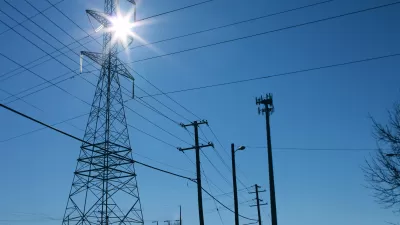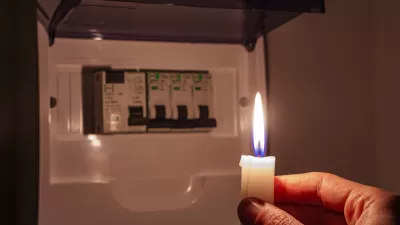Utilities profit from building more power plants—a flawed model for a diminishing natural monopoly.

David Roberts argues that New York State's Reforming the Energy Vision (REV) may be "the most important clean energy policy initiative in the country today." Not only can it change a poorly aligned incentive structure but also will contribute to national carbon reduction targets, setting an example for the rest of the country.
"Reforming utilities is a perilous process, with intense politics and high stakes. Reliable service must be maintained throughout any transition — it's like rebuilding an airplane in flight," Roberts warns. There remain many uncertainties about how and whether or not it will work, but he opines that New York's innovative vision is a clear path to real reform.
The REV will tackle grid inefficiencies by smoothing out the load profile - reducing congestion at peak energy hours. "To do that, it needs to encourage energy efficiency, demand shifting, and distributed energy resources (DER)s — all of which, in the traditional regulatory model, reduce utility revenue." This is because utilities make money by building more power plants—not by improving efficiency of existing plants.
To fill the gap in revenues from reduced capital expenditures, the REV proposes that utilities are restructured to be distributed service providers (DSPs), responsible for maintaining the grid but also involved in creating and managing “markets where third parties can compete to provide energy products and services on the retail side, things like energy storage, demand response, and distributed generation,” Roberts explains.
"The boundary of the [public utility's] natural monopoly has moved inward again. What remains of it is grid operations and reliability planning — that is, running the distribution grid itself. That's the only function that is still properly the purview of a publicly accountable, regulated utility."
FULL STORY: New York's revolutionary plan to remake its power utilities

Planetizen Federal Action Tracker
A weekly monitor of how Trump’s orders and actions are impacting planners and planning in America.

Congressman Proposes Bill to Rename DC Metro “Trump Train”
The Make Autorail Great Again Act would withhold federal funding to the system until the Washington Metropolitan Area Transit Authority (WMATA), rebrands as the Washington Metropolitan Authority for Greater Access (WMAGA).

DARTSpace Platform Streamlines Dallas TOD Application Process
The Dallas transit agency hopes a shorter permitting timeline will boost transit-oriented development around rail stations.

Renters Now Outnumber Homeowners in Over 200 US Suburbs
High housing costs in city centers and the new-found flexibility offered by remote work are pushing more renters to suburban areas.

The Tiny, Adorable $7,000 Car Turning Japan Onto EVs
The single seat Mibot charges from a regular plug as quickly as an iPad, and is about half the price of an average EV.

Supreme Court Ruling in Pipeline Case Guts Federal Environmental Law
The decision limits the scope of a federal law that mandates extensive environmental impact reviews of energy, infrastructure, and transportation projects.
Urban Design for Planners 1: Software Tools
This six-course series explores essential urban design concepts using open source software and equips planners with the tools they need to participate fully in the urban design process.
Planning for Universal Design
Learn the tools for implementing Universal Design in planning regulations.
Municipality of Princeton
Roanoke Valley-Alleghany Regional Commission
City of Mt Shasta
City of Camden Redevelopment Agency
City of Astoria
Transportation Research & Education Center (TREC) at Portland State University
US High Speed Rail Association
City of Camden Redevelopment Agency
Municipality of Princeton (NJ)




























